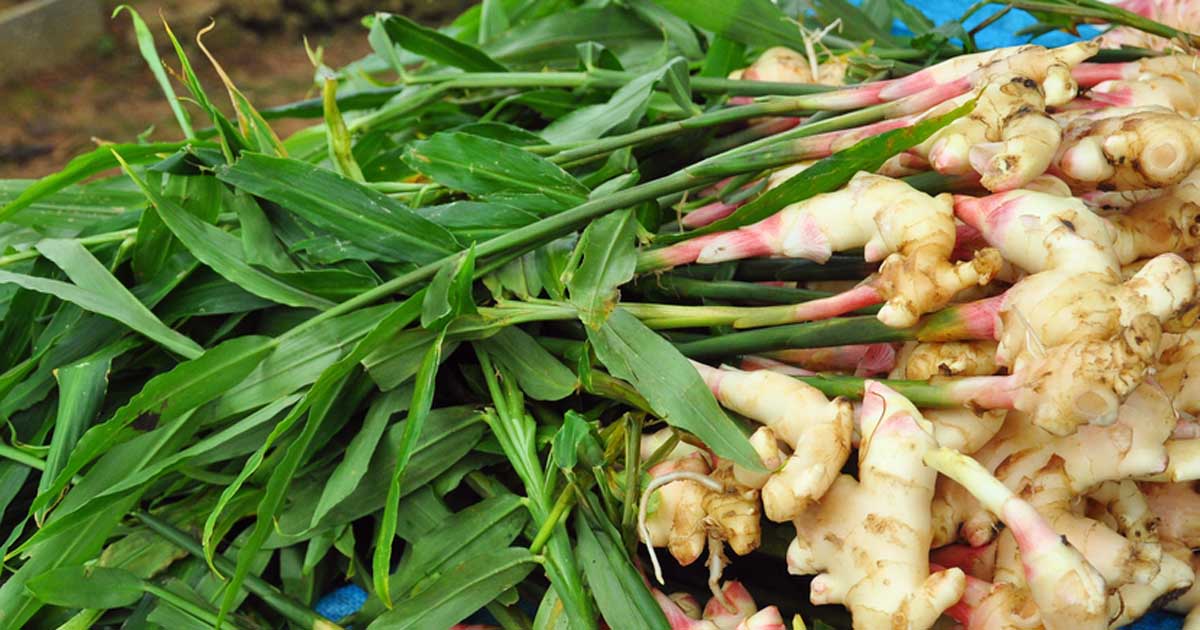With their lush green foliage and unique cone-shaped blooms, ginger plants are easily recognized in tropical and subtropical gardens. Ginger is also a popular and versatile culinary ingredient. This photo gallery takes a close look at different ginger plant species and the many ways ginger is used.
Ginger Flower and Foliage
Ginger plants belong to the Zingiberaceae family. Most produce attractive bracts of flowers in shades of white, yellow, red, or pink. The leaves are alternately arranged, simple, and lush green. Many species are grown as ornamentals.
![Torch ginger flowers closeup][]
- Torch ginger in bloom displaying the typical cone shape of ginger flowers. The red bracts attract hummingbirds.![Chinese yellow ginger foliage][]
- Large, pleated leaves of Chinese yellow ginger. The leaves and rhizomes contain essential oils used in herbal remedies. ![Beehive ginger inflorescence][]
- Beehive ginger produces a showy, dense cone of yellow bracts that resembles a beehive. It makes a dramatic landscape plant.
Growing Ginger
Ginger is easy to grow from rhizome pieces It thrives in humid, warm conditions and dappled shade. Ginger flourishes as a houseplant or in outdoor containers in temperate climates![Ginger plant in pot][]
- Store-bought ginger rhizomes readily sprout when planted in pots and kept moist. Leaves emerge first, then flowers.![Ginger field][]
- Ginger is cultivated on a large scale as a commercial spice crop in tropical areas of Asia, Africa, and the Americas.
Culinary Uses for Ginger
Both fresh and dried ginger root are indispensable in Asian cuisines and many savory dishes worldwide. It provides a hot, zingy flavor.![Ginger root pile][]
- Peeled ginger root ready to be chopped, minced, or grated for recipes. It adds punch to soups, curries, marinades, and more.![Ground ginger][]
- Dried and powdered ginger is convenient for baking. It’s also brewed into spicy-sweet ginger tea.![Ginger lemon drink][]
- Sliced ginger infuses flavor and potential health benefits into lemon water or tea. It aids digestion.
Ginger’s Medicinal Uses
For centuries ginger has been valued in traditional medicine across cultures. It may help relieve nausea, inflammation, pain, and more. ![Ginger capsules][]
- Ginger supplements provide concentrated doses. Studies suggest ginger may reduce migraine, arthritis, and chemotherapy nausea.![Skin cream ingredients][]
- Ginger extracts enhance anti-inflammatory skincare products. Ginger oil relieves joint and muscle soreness when applied topically.![Ginger tea][]
- Soothing ginger tea eases stomach upset. Compounds in ginger combat nausea-inducing serotonin.
This visual overview displays the ornamental appeal and versatile uses of the amazing ginger plant – in the landscape, kitchen, and medicine cabinet.

Growing Ginger Plant From Root (93 Days Time Lapse)
FAQ
How do I identify a ginger plant?
Do all ginger plants produce edible ginger?
What does an edible ginger plant look like?
What does a ginger root plant look like?
How many ginger plant pictures are there?
Browse 18,659 authentic ginger plant stock photos, high-res images, and pictures, or explore additional ginger plant isolated or ginger plant drawing stock images to find the right photo at the right size and resolution for your project. Twenty spices. XXXL. Second part. Pile of ginger root on green placemat.
Are ginger plant stock photos available?
Ginger Plant stock photos are available in a variety of sizes and formats to fit your needs.
What does a ginger plant look like?
The above-ground portion of the plant looks like thick-stemmed grass, and it is the rhizomes underground that are most commonly used. The flowers have pale yellow petals with purple edges. Ginger is a tropical plant native to Asia’s hot, equatorial areas, and it has a long history in Asian cooking and herbal medicine (for at least 4,400 years!).
What are the different types of ginger plants?
Check out the best Types of Ginger Plants down here. 1. Common Ginger 2. Beehive Ginger 3. Bitter Ginger 4. Myoga Ginger 5. Crepe Ginger 6. Hidden Ginger 7. Butterfly Lily Ginger 8. Shell Ginger 9. Dancing Ladies Ginger 10. Yellow Ginger 11. Red Ginger 12. Torch Ginger 13. Mango Ginger 14. Kahili Ginger 15. Thai Ginger 16. Pineapple Ginger 17.
Is Ginger a perennial?
Ginger is a perennial plant of the Zingiberaceae family and there are many species in this group. Ginger root is a thick fibrous rhizome that clumps together and stems out in various directions. In fact, the name “ginger” comes from the Sanskrit word for ‘horn-root.’
What is the botanical name of ginger lily?
Botanical Name: Hedychium gardnerianum Other Name: Fragrant Ginger Lily, Kahila Garland-Lily This plant is native to Himalayan regions and grown primarily for ornamental purpose. Large dramatic foliage and showy, fragrant flowers make it a truly exotic tropical plant.
- The Ultimate Guide to Growing Strawberries in Raised Beds - August 8, 2025
- No-Dig Garden Beds: The Easiest Way to Grow a Beautiful Garden - August 6, 2025
- How to Protect and Preserve Wood for Raised Garden Beds - August 6, 2025
